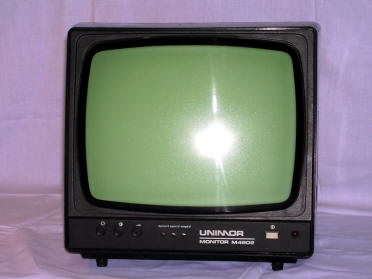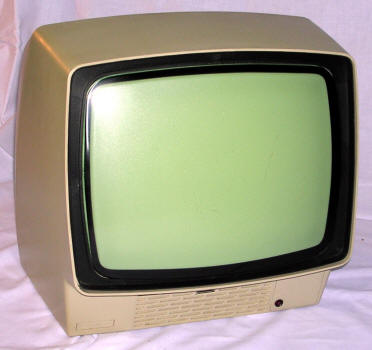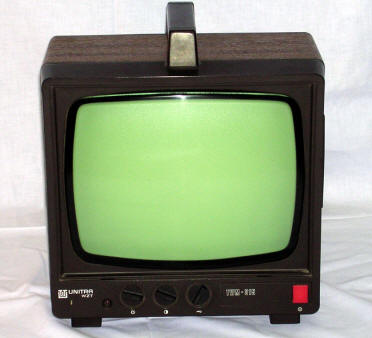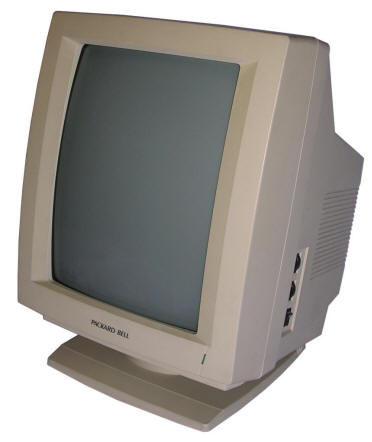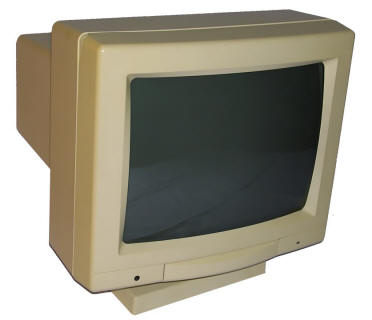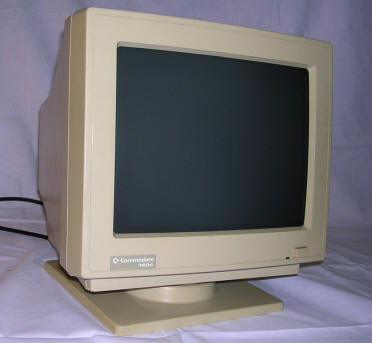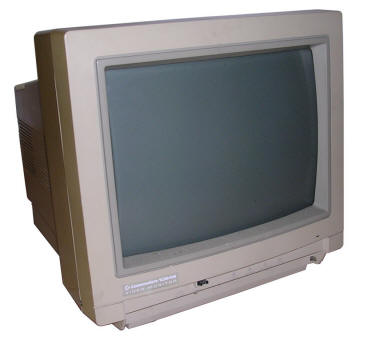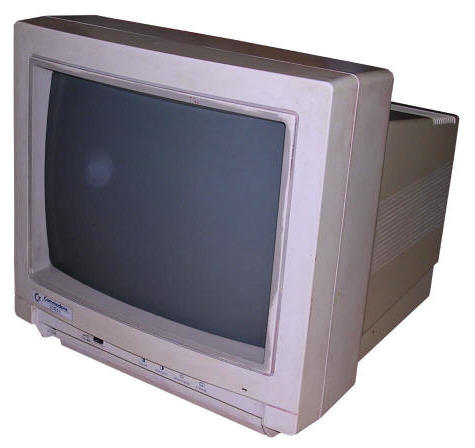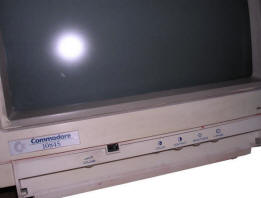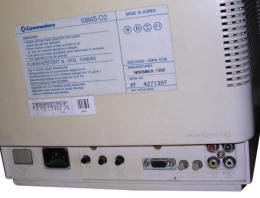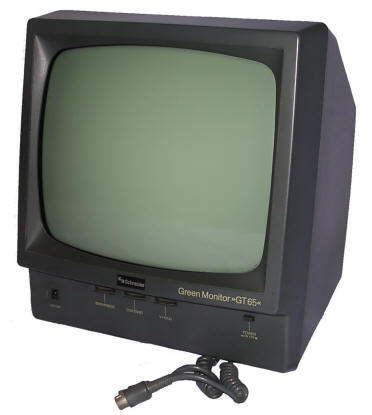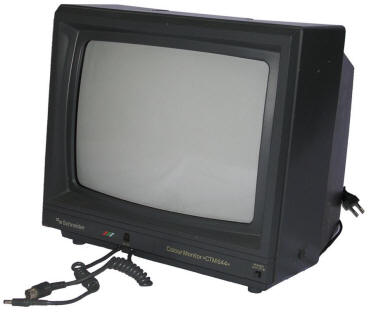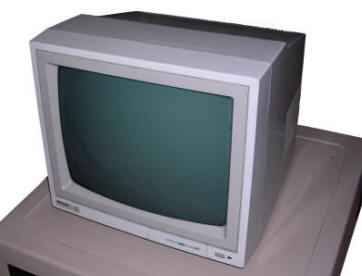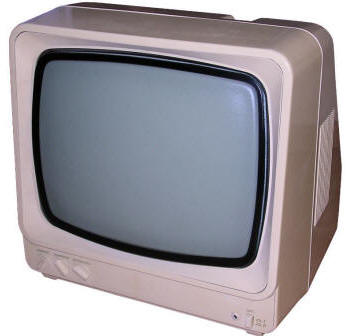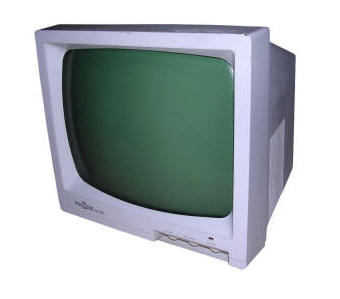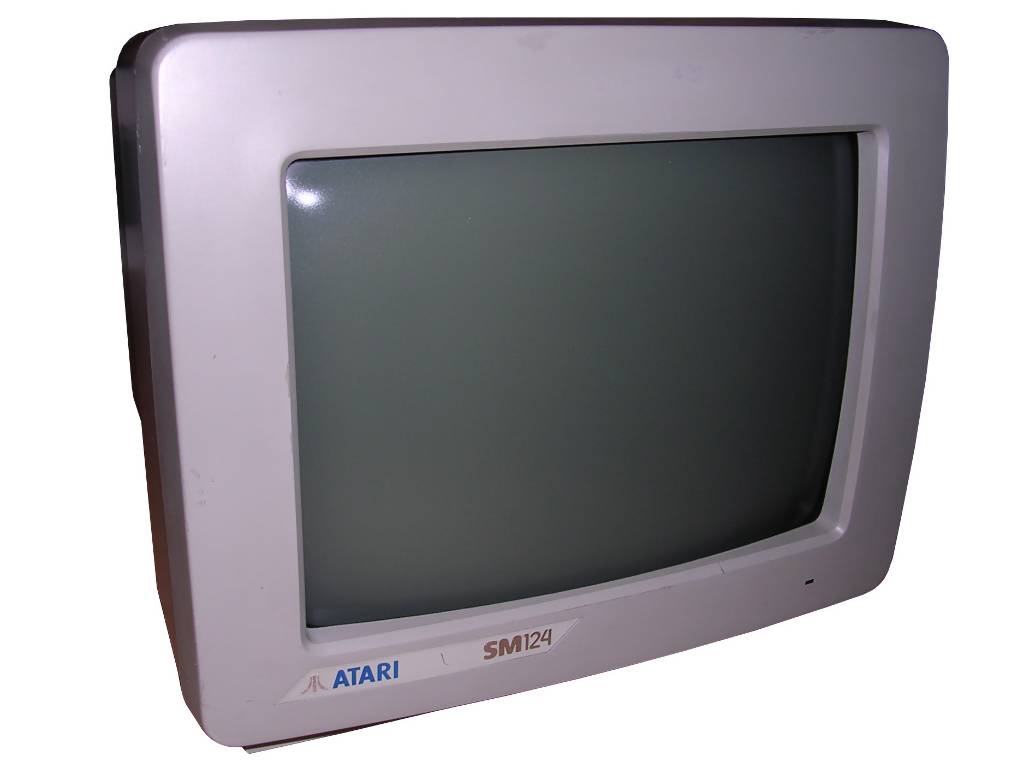Monitors
Many 8-bit microcomputers could be used with an ordinary TV as monitor. It was good for gaming, but not for serious long-time work, as the picture was not sharp enough and flickered too much, causing headache after few hours of text editing or programming. Special display units with monochrome (usually green) or color picture tubes were used. Some of them were simple units based on TV sets with green CRTs.
| Unimor M4902 |
|
|||
| Manufactured by: Unimor | ||||
| Type: Monochrome, green screen 12" | ||||
| Conected to: Composite/Luma | ||||
|
Capabilities: - DIN type input - Mono speaker
|
||||
| Small green monitor, adapted from Neptun 171 TV. It was manufactured from 1988 to 1990 in Unimor, Gdańsk. It was quite good for microcomputers. | ||||
|
|
||||
|
|
||||
| Neptun 156/M156B |
|
|||
| Manufactured by: Unitmor | ||||
| Type: Monochrome (green) 12" | ||||
| Connected to: Composite (luma) | ||||
|
Capabilities: - DIN socket - Mono speaker - Possible to run from 12V DC power supply (some units don't have this) - Power LED - It is known that it'll run with CGA signal. - Available with white, light-brown, black (rare!) or dark-gray casing colors. |
||||
|
This monochrome monitor is based on Neptun portable TV. It is
quite popular in Poland, as it was used with Elwro 800 Junior,
Meritum and other Polish computers and it was bought with many
foreign micros as monitor.
There's a myth that the only difference between 156 and 156B was the 12V power socket. Unfortunately that's not true, as I have both 156 and 156Bs with these sockets. Modified 156 was Neptun 159 - monitor for Bosman 8 computer. Although popular, it was relatively expensive, but many components could be bought spearately. There was a DIY project in "Młody Technik" (Young Engineer) magazine describint how to build monitor similar to Neptun 156 from separate modules available in a few shops. The only problem there was picture tube, which was a bit hard to get. More information - there was one version with short silver "legs" glued to the bottom. It was made for MK-45 microcomputer, so these "legs" got into holes making monitor one piece with central unit. |
||||
|
|
||||
|
|
||||
| TWM-315 |
|
|||
| Manufactured by: Unitra WZT (Warsaw) | ||||
| Type: Monochrone (green) 12" | ||||
| Connected to: Composite (Luma) or RGB (DB9) | ||||
|
Capabilities: - Could be used with CGA graphics - Green CRT - Mono speaker - DIN input - TTL DB9 input.
|
||||
| This
monitor was based on Vela 206 TV, a small TV which could be
easily re-made into monitor by plugging audio, video and ground
signals to 3 wires (this modification was quite popular). But TWM-315 had a TTL video decoder allowing
to plug CGA graphics in. There are a few units with white CRT tubes known. These are prototypes made of Vela T206 portable TV sets. |
||||
|
9-pin MALE connector! |
||||
|
|
||||
| Packard Bell PB1518DT |
|
|||
| Manufactured by: Packard Bell | ||||
| Type: Monochrome (white) 15" portrait | ||||
| Connected to: Dedicated graphics card | ||||
|
Capabilities: - 736x1008 resolution (in fact it's higher, but graphics card can suport only this) - Proprietary graphics card required - Graphics expansions for IBM PC and Atari computers - White screen
|
||||
|
This monitor displays monochrome (black and white) picture in
portrait align, making the screen look like a sheet of paper. It
makes text editing in WYSIWYG applications easier. To support
this, a non-standard graphics card, made by Genius, was needed.
There are 2 known cards, one for PC (8-bit ISA) and one for
Atari (but which?). As I don't have any of these cards, I can't say more about this monitor. |
||||
|
Article from InfoWorld March 06 1989 (and I have no idea what pinout it has on its connector) |
||||
|
|
||||
| Commodore 1084ST |
|
|||
| Manufactured by: Likom? for Commodore | ||||
| Type: Color 14" | ||||
| Connected to: RGB / Composite / Luma | ||||
|
Capabilities: - Color picture tube - 640x512 maximmum resolution - Composite/Luma-chroma chinch, DB9 RGB(I) connectors - Stereo speakers - Tilt stand - Automatic chinch input switching - if no connector is placed in Chroma, it takes chrominance from luma chinch assuming it's composite. |
||||
|
[update:20160819]Commodore 1084ST was, from the outside, similar to 1084 with a few new features:
circuits supporting a bit higher resolution, new case design, tilting stand and DB9
connector's pinout totally messed up. Inside, the electronics is mostly a mix of different brands, ICs are from ST or (power supply) Philips/Signetics. Most units weren't made by Commodore at all! According to the Commodore monitors list this model has been probably made in Malaysia by Likom. There were 2 versions of this monitor. First one, from 1992, with Commodore marking in front, they have distinguishable brown/gray protruding frame around CRT. My unit from 1994 is post-Commodore but before Escom and is totally white in front. It was marketed as "CGA" but 99% of post-commodore units have NO RGBi support making it unusable with CGA. It was sold as Amiga 600 semi-professional monitor, but it was used with many applications. Unfortunately, many units were made with different pinouts of DB9 connector. I suggest you to take ohmmeter and find Ground pins to make sure which pinout is yours. My unit comes from restaurant where it was used as security camera monitor. It seems that all people were smoking there, and yes, its case was white. Most photos of computer screens on this site comes from this monitor. |
||||
|
|
|
|||
|
|
||||
|
|
||||
| Commodore 1404 |
|
||||
| Manufactured by: Hyundai? for Commodore | |||||
| Type: Monochrome (amber) 13" | |||||
| Connected to: DB9 (MDA/Hercules) | |||||
|
Capabilities: - Displaying picture from MDA or Hercules - Built-in cable with 9-pin conenctor for MDA/Hercules cards.
|
|||||
|
Released in 1990, it was probably designed for Commodore PC-x0
series of PC-compatible Commodore computers. But it's NOT
made by Commodore AT ALL! Who made it? I have THE SAME device branded Hyundai and the only difference is the label. If you want proof see photos. My unit works well with MDA, but in Hercules graphics mode it runs out of sync and picture floats upwards. It's probably problem with the particular unit, as Hyundai has no problem in these resolutions. |
|||||
|
|
|
|
|||
|
|
|||||
|
See this page for service manual. |
|||||
| Commdore 1084S-D2 |
|
||
| Manufactured by: Daewoo for Commodore | |||
| Type: Color, 14" | |||
| Connected to: Composite Chinch / DB9 RGB | |||
|
Capabilities: - Composite and RGB inputs - Stereo speakers.
|
|||
| A bit different model. It has no GREEN option and different pinout, dedicated to Amiga computers. Commodore ordered monitors in many different companies, so there are few 1084 models. | |||
|
|
|||
| Schneider GT-65-2 |
|
|||
| Manufactured by: Schneider | ||||
| Type: Monochrome (green) 12" | ||||
| Connected to: Amstrad CPC's video port | ||||
|
Capabilities: - Green picture tube - Built-in 5V and 12V DC power supply to power the computer. - 2 "Carrying handles" in model GT-65-2 (these 2 holes in rear)
|
||||
| Small monitor used with Amstrad CPC computers. As Amstrad/Schneoder CPC computers have no conventional video output, users were forced to use these monitors or expensive RF modulator units. More, CPCs had no power supply units outside of monitor, so dedicated RF modulators had it built-in too. | ||||
|
|
||||
|
|
||||
|
|
||||
| Schneider CTM-644 |
|
|||
| Manufactured by: Schneider | ||||
| Type: Color 14" | ||||
| Connected to: Amstrad CPC's video port | ||||
|
Capabilities: - Quite nice color display - 5V and 12V DC power supply built in - Carrying handle
|
||||
| CTM-644 was a color monitor for Amstrad CPC computers. It wasn't popular in Poland, as it was more expensive than monochrome version. | ||||
|
|
||||
|
|
||||
|
|
||||
| Philips Computer Monitor 80 |
|
|||
| Manufactured by: Philips | ||||
| Type: Mono 12" | ||||
| Connected to: Cinch connector | ||||
|
Capabilities: - Green phosphor CRT - Sound output (mono)
|
||||
| A small CRT monitor for most computers which can output monochrome signal. | ||||
|
|
|
|||
|
|
||||
| Biazet MMK-127 |
|
|||
| Manufactured by: Unitra Biazet (Poland) | ||||
| Type: Mono 12" | ||||
| Connected to: 5-pin DIN connector | ||||
|
Capabilities: - White phosphor CRT (there were green versions too) - Sound output (mono)
|
||||
| This model was manufactured with white or green CRT. It was manufactures in late 1980s and maybe in 1990. My unit has white phosphor CRT, but there are problems with emission (poor contrast) due to prolonged usage with maximal brighness. | ||||
|
|
|
|||
|
|
||||
|
|
||||
| Peacock AI-100 |
|
||
| Manufactured by: Peacock | |||
| Type: Mono 12" green | |||
| Connected to: Cinch connector | |||
|
Capabilities: - Green monochrome CRT - Sound (mono) - Contrast/brightness regulation
|
|||
|
A typical green-phosphor monitor for 8-bit computers. It has
built-in sound amplifier and mono speaker.
My unit is not in good shape, but it works. |
|||
|
|
|||
|
|
|||
| Atari SM124 |
|
||
| Manufactured by: Atari | |||
| Type: Mono 12" white | |||
| Connected to: Atari ST 15-pin connector | |||
|
Capabilities: - White high-contrast CRT - Sound (mono)
|
|||
|
Typical display for Atari ST computers. Gives good image with
nice contrast, both picture and sound are taken from Atari ST's
DIN connector.
In fact these displays were made by other company and sold as Atari. Probably Goldstar manufactured them and installed Atari-compatible connectors and cables. Links: |
|||
|
|
|||
|
|
|||





